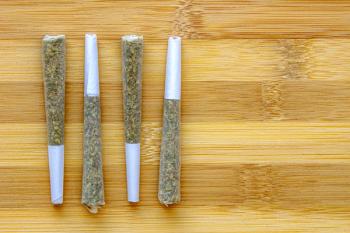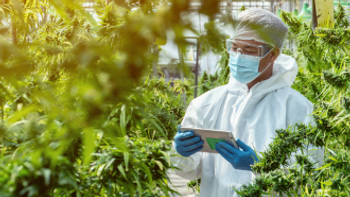
Cannabis Science and Technology
- April 2020
- Volume 3
- Issue 3
Co-Solvent Ethanol Injection Helping CO2 Extraction
This study considers the use of ethanol as a co-solvent in a carbon dioxide extraction of cannabinoids and its effects on extraction time and overall raw yield.
This study considers the use of ethanol as a co-solvent in a carbon dioxide extraction of cannabinoids and its effects on extraction time and overall raw yield. A control test was initially conducted to calculate the volumetric flow of liquid and supercritical CO2 and to record the amount of material collected. Additional runs were then performed with the injection of a 5% by volume stream of ethanol, first with hops and then confirmed on cannabis. Upon separation of the oil from the ethanol it was determined that the oil was extracted up to 300% faster and with roughly 2% greater overall yield.
There is much discussion around increasing solubility power of a solution with the assistance of a co-solvent, but few, if any, studies consider the increase in solubility of CO2 with the presence of ethanol as a co-solvent. Often, various solvents are mixed together to obtain a larger amount of solute before it’s saturated. However, unlike many experiments involving co-solvents, CO2 as a solvent cannot exist at room temperature and pressure. That means, to determine if the solubility of the solution has increased, a dynamic research model is needed instead of the typical static models that can be used with other solvents. An increase in the solubility of the solution is just one concern. The ability of CO2 to select different cannabinoid fractions at specific times must still be retained, proving the introduction of ethanol can improve extraction times without detracting from the flexibility offered by CO2 as a solvent. Otherwise, a straight ethanol extraction might be chosen over a carbon dioxide and ethanol co-solvent extraction. Throughout this study, two key factors were considered: increase solubility as measured by an increase in yield, and extraction selectivity as measured by color and viscosity. The oils that are lighter in color and less viscous offer a decrease in post-processing time, making them more desirable to many end users. These more volatile components will separate out sooner than the waxes, fats, and chlorophylls that contribute to a darker, thicker end product.
Experimental
This experiment was completed with a beta co-solvent module that consisted primarily of an ethanol tank and pump with some instrumentation and a check valve to ensure unidirectional flow of the ethanol into the system (see Figure 1). The ethanol tank supplied the ethanol pump with room pressure and room temperature ethanol. The pump would then increase the pressure of the ethanol from atmospheric to the operating pressure of the carbon dioxide system. A variable frequency drive would control the speed of the positive-displacement pump, and therefore the flow rate of the ethanol, to allow for a specific injection quantity. Volumetric percentages were chosen based on the standard for measuring co-solvent efficiencies. Finally, the necessary pressure valves and reliefs were added to connect this module to a CO2 extraction system. The piping and instrumentation diagram of the co-solvent test system is shown in Figure 1. A CO2 flow meter, placed in line between the separators and the pump on the closed loop CO2 extraction system, was used to monitor the flow of CO2. This returned a standard cubic feet per minute (SCFM) for the CO2, used to calculate a L/min flow rate based on liquid or supercritical CO2 at either 1200 PSI and 75 °F or 1800 PSI and 105 °F. The closed loop system allowed for the conversion of SCFM (mass flow) to L/min (volumetric). (See upper right for Figure 1, click to enlarge.)
The connection point between the co-solvent module and the CO2 extraction system was located just before a temperature control heat exchanger (red arrow in), which is located immediately before the inlet tubing for the extractor, where the raw material is located. (See upper right for Figure 2, click to enlarge.) This structure would allow the ethanol to mix with the CO2 stream, thus avoiding a temperature drop and ensuring the mixture was homogenized before going into the extractor. The CO2 and co-solvent mixture would then travel through the raw material and collect the oil before traveling to the separator. There the saturated solution would be depressurized, allowing the mixture of oil and ethanol to fall out of the solution and allowing the gaseous CO2 to return to be recompressed by the diaphragm compressor.
This experiment was performed on both hops and cannabis, at both subcritical and supercritical parameters. For the subcritical test, parameters of 1200 PSI and 75 °F were used. For the supercritical test, parameters of 1800 PSI and 105 °F were selected.
This was done to match the standard operating parameters and capabilities of the CO2 system. Any subcritical and supercritical parameters could have been used. Due to the increased pressure requirements and the associated losses in volumetric efficiency in the CO2 compressor, the main difference between the subcritical and supercritical runs was the CO2 flow rate. In turn, the ethanol flow rates differed. But since both subcritical and supercritical were compared to their control tests, and not to each other, this did not factor into the findings. The original experiment at our facility in Ohio was done using hops because of regulations in Ohio prohibiting testing with cannabis. The hops used were Columbus hops. In each test, hop pellets were ground, their input weights recorded, and then loaded into the extractor to be used as the raw material. A control test was done on both sets of data points before the co-solvent test was run. During this test, data samples were taken every 10 min and weights were recorded to get a yield curve in grams of oil versus time for a CO2 only extraction. The sample time started only after the system was up to pressure and flow had begun between the extractor and the separator. A representative portion of every sample was kept to evaluate the control extraction relative to the co-solvent extraction in terms of both color and consistency. After the control tests were completed, the same tests were replicated, with the only difference being the addition of a 5% by volumetric flow ethanol stream. This ethanol stream was started only after the system was up to pressure and flow had begun. Samples were again taken every 10 min, with each sample containing both botanical oil and ethanol. The samples were weighed and kept apart from one another until separation of the oil from the ethanol. Each individual ethanol and oil sample was then put through a rotary evaporator to separate the ethanol from the extracted oil. Both the weight of the oil and the volume of the ethanol were recorded. The ethanol volume was recorded to verify the flow rate of the ethanol pump since there was no ethanol flow meter present during the test runs. In the absence of an ethanol flow meter for this experiment, measurements of ethanol used were taken throughout the process to verify that the amount used was consistent with the pump motor speed. Once the control and experimental hops tests were completed, subsequent control and experimental tests were run in Pueblo, Colorado to verify the results on cannabis. The cannabis strain used was a high tetrahydrocannabinol (THC) strain that had been decarboxylated prior to the extraction test. Test cannabis had also been ground to approximately 100 µm for the test runs. The CO2 extraction system used in conjunction with the cannabis test had a higher CO2 flow rate than the one used with the hops tests, but the ethanol flow rate was increased to keep the volumetric percentages the same.
Results and Discussion
The hops test matrix can be seen in Tables I and II. (See upper right for Tables I and II, click to enlarge.)
Sample 11 on runs 1 and 2 were both taken after an additional hour of running to determine the maximum amount of oil that could be obtained. The benefits of the co-solvent were delayed because the ethanol pump did not start until the system was up to pressure and CO2 flow had started. This was due to the time it took for the ethanol to travel through the heat exchanger and into the raw material, before exiting the raw material to the separator. This travel time was determined by the CO2 flow rate and the length of tubing through which the ethanol would travel before mixing in solution with the carbon dioxide and botanical material. This delay inspired an option in later versions to allow a terpene extraction to occur before the co-solvent portion of the extraction takes place. Many end users perform a CO2-only fractional terpene extraction before the cannabinoid extraction, so this method is representative of one common practice. The delay in co-solvent assistance is evident in the supercritical run as the flow rate was much slower than the subcritical run. This can be noted in the amount of ethanol in the run as well. Comparing the subcritical runs and supercritical runs independently, we can see there is an increase in speed and, in the case of the subcritical run, an increase in the maximum amount of material extracted. A graphical representation of these runs can be seen in Figures 3 and 4. (See upper right for Figures 3 and 4, click to enlarge.)
During the testing process it was clear that additional benefits include both the ease in collecting and cleaning the separator when using a co-solvent. The resulting oil–ethanol mixture was nearly homogenized and could be easily transitioned into a winterization process without the necessary hotplate and stirrer. This benefit manifests as a reduction in energy consumption and time required for post-extraction processing activities. After these tests, it was determined that the presence of ethanol increases the solubility power of the CO2, and that the CO2 is still selectable even with the addition of the co-solvent. This was clear from the results of the supercritical test, as seen in the slower speed shown in Figure 5. (See upper right for Figure 5, click to enlarge.)
The cannabis test matrix can be seen in Table III and IV. (See upper right for Tables III and IV, click to enlarge.)
With the cannabis test runs, we were able to increase the flow rates of the CO2 to achieve a better representation of flow rates currently available on the market. We were also able to increase the raw material bed to allow for a longer extraction curve for the increased flow. Extraction curves for the above data can be seen in Figures 6 and 7. (See upper right for Figures 6 and 7, click to enlarge.)
During these runs, the delay in starting the ethanol pump was reduced to achieve a better overall increased extraction curve. In this test, the co-solvent pump was started as soon as liquid or supercritical CO2 was flowing in the lines. This was determined by the pressure approaching 1000 PSI for each run. Midway through the fifth pull, the ethanol pump was stopped to replicate previous experiments by extracting all the oils around this time. The extraction curve for both super and subcritical CO2 were similar. The extraction on the subcritical was roughly 175% faster, and extraction on the supercritical was 300% faster. Furthermore, the mixture darkened in the subsequent samples and held a similar pattern to that seen in hops.
Conclusions
While more testing is needed to consider additional factors about ethanol co-solvent runs, these tests proved the effectiveness of the method at these parameters. An injection of a 5% co-solvent stream can increase efficiency by more than 100%, while still maintaining some selectivity and adding the benefit of cutting out homogenization from the post-processing winterization process. Ethanol being a polar solvent has its pros and cons, but using it in solution with CO2 helps to reduce the removal of the unwanted chlorophyll. With the addition of ethanol to the solution, dialing into a set of extraction parameters to extract desirable cannabinoids and terpenes while leaving the unwanted compounds in the raw material can be accomplished not only with pressure and temperature adjustments of the CO2, but can now also be adjusted by raising or lowering the concentration of ethanol in the stream. This method of co-solvent injection is also beneficial in that all the ethanol pumped into the CO2 system is retained with no loss. This is because of the saturation into the plant material, as is the case with typical ethanol extractions, which can leave 10% or more of the ethanol behind in the plant material. This occurs because ethanol is soluble in liquid of supercritical CO2, allowing for natural movement of any remaining ethanol from the extractor to the separator during recovery.
About the Author
Sam Shomper is a senior mechanical engineer with Apeks Supercritical, a leading CO2 extraction system manufacturer. Sam has been with the company for almost six years, after graduating from The Ohio State University, where he got a BSME. He leads the team innovating the co-solvent technology at Apeks and has spearheaded several other innovative technologies over the years. Direct correspondence to: SamS@apekssupercritical.com.
How to Cite this Article
S. Shomper, Cannabis Science and Technology3(3), 46–51 (2020).
Articles in this issue
over 5 years ago
Beyond Potency: Flavonoids-the Purples, Reds, and Bluesover 5 years ago
The Root of Success: Using the Right Growth SubstrateNewsletter
Unlock the latest breakthroughs in cannabis science—subscribe now to get expert insights, research, and industry updates delivered to your inbox.





